Trees Birds Mammals Fish Amphibians Reptiles
Wild Algarve
Bookshop
Scutellinia mirabilis Dissing & Sivertsen
Phylum: Ascomycota - Class: Pezizomycetes - Order: Pezizales - Family: Pyronemataceae
Distribution - Taxonomic History - Etymology - Identification - Reference Sources
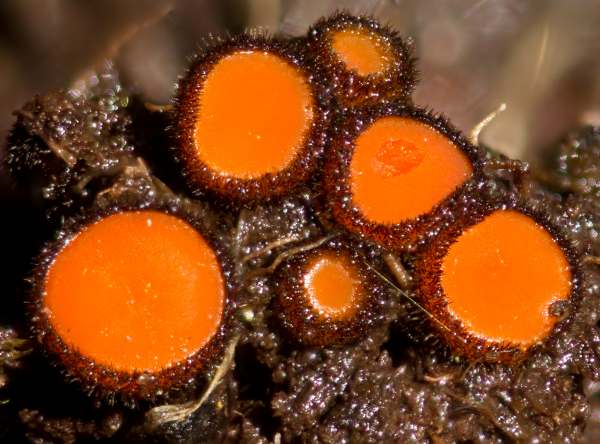
This red/orange, short-haired, disc fungus belongs to the 'spore shooter' phylum, the Ascomycota (commonly referred to as the ascomycetes). It is one of the thirty or so Scutellinia species found in the UK. Like all 'spore shooters' the spores are contained in asci. The asci resemble tubes, and this is where the spores mature (usually eight spores per tube). The club-shaped 'packing' between the asci are called paraphyses, and together the asci and the paraphyses make up the fertile upper surface of the disc. When the spores are mature they are 'shot' from the asci under pressure.
Many guide books only include one species of Scutellinia - Scutellinia scutellata, the Eyelash Fungus', as it is commonly called - probably because microscopy is always required to identify members of this genus.
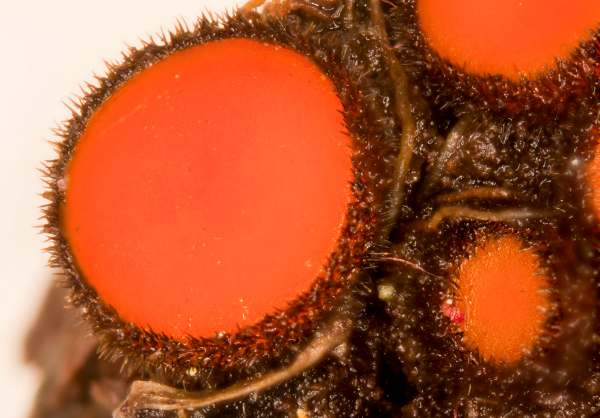
Distribution
A very rare find in Britain, there are only two previous records of Scutellinia mirabilis in the UK. The specimens shown on this page were found in The New Forest, in Hampshire, England, under a group of pine trees where cattle congregate. It appears to be growing from the exposed grass roots where the cattle have disturbed the ground.
The identity of the specimens shown on this page was confirmed from fresh samples which were sent to Beñat Jeannerot, a Scutellinia expert in France.
Taxonomic history
Danish mycologist Henry Dissing (1931 - 2001) working with Norwegian Sigmund Sivertsen (b. 1929) described this species in 1983 and gave it what remains its accepted scientific name Scutellinia mirabilis.
Etymology
The specific epithet mirabilis is Latin for remarkable or wonderful, probably a reference to the vivid colour of these fungi.
The key to identifying to species level the various species of Scutellinia and Cheilymenia (the other main group of eyelash-fringed disc fungi) of which there are close on 50 known in Britain and Ireland, is by microscopic examination of asci, spores and any hairs or 'lashes' that cover the infertile surface.
Identification Guide
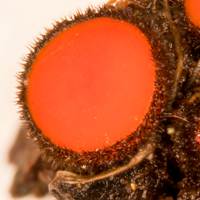 |
Body
A deep orange/red coloured disc, 2-9mm across with a dense mat of short, rigid hairs around the margin and on the infertile outer surface. |
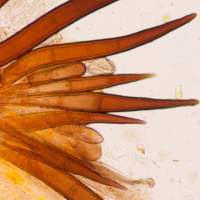 |
Marginal hairs
Septate, 200-400 x 14-19µm, brown, deep rooted.
|
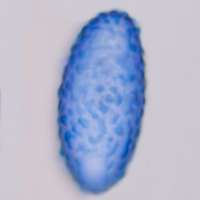 |
Spores
23.5-28 x 11.5-15µm; narrowly ellipsoidal to fusiform, ornamented with warts, some of whichcoalesce into short ridges. The 'skin' of the spore loosens when boiled in Lactophenol Cotton Blue stain.
Spore print
White. |
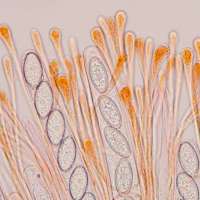 |
Asci
Cylindrical, operculate, 200-250 x 16-18μm; hyaline; uniseriate with eight spores per ascus.
Paraphyses
Septate; pale orange, cylindrical, 2-3µm diameter with clavate tips 7-10µm across. |
Odour/taste |
Odour not distinctive. |
Habitat & Ecological role |
Saprobic, on disturbed mud with grass roots. |
Season |
Too few records but possibly spring - summer. |
Similar species |
All of the Scutellinia fungi appear quite similar to the naked eye, and a microscope and some experience is needed to tell them apart.
Sarcoscypha austriaca, the Scarlet Elf Cup, is much larger and deeper, bright red
and grows on dead twigs and branches in mossy woods and sometimes under damp hedgerows; its rim is not fringed with hairs. |
Reference Sources
René Dogoud. Vincent Ruiz-Badanelli (2010). Sur deux espèces du genre Scutellinia, sous-genre Legalia T. Schumach., Scutellinia minor et S. mirabilis : Ascomycete.org, 2 (1) : 25-31.
Schumacher T. (1990). The genus Scutellinia (Pyronemataceae).Opera Botanica 101: 107 pp.
Dissing H. & Sivertsen S. 1983. Operculate Discomycetes from Rana (Norway) 4. Octospora hygrohypnophila, Peziza prosthetica and Scutellinia mirabilis spp. nov. Nordic Journal of Botany, 3 (3) : 415-421.
Schumacher, T. (1988). The Scutellinia battle: the lost, missing and dead. Mycotaxon 33: 149-189.
Dennis, R.W.G. (1981). British Ascomycetes; Lubrecht & Cramer; ISBN: 3768205525.
Breitenbach, J. & Kränzlin, F. (1984). Fungi of Switzerland. Volume 1: Ascomycetes. Verlag Mykologia: Luzern, Switzerland.
Medardi, G. (2006). Ascomiceti d'Italia. Centro Studi Micologici: Trento.
Paul M. Kirk, Paul F. Cannon, David W. Minter and J. A. Stalpers (2008). Dictionary of the Fungi; CABI.
Taxonomic history and synonym information on these pages is drawn from many sources but in particular from the British Mycological Society's GB Checklist of Fungi.
Acknowledgements
This page includes pictures kindly contributed by David Kelly.
Top of page...
Fascinated by Fungi. Back by popular demand, Pat O'Reilly's best-selling 450-page hardback book is available now. The latest second edition was republished with a sparkling new cover design in September 2022 by Coch-y-Bonddu Books. Full details and copies are available from the publisher's online bookshop...